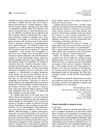TLDR New treatments for hair loss show promise, especially with antiandrogens, minoxidil, and autoimmune therapies.
The document discussed promising developments in the treatment of non-cicatricial alopecia as of 1988. It highlighted three key areas: the potential of topical antiandrogens for treating androgenetic alopecia in men, ongoing research with minoxidil that could enhance understanding of follicular function regulation, and preliminary experiences with therapies for alopecia areata, which were based on its autoimmune nature and aimed to establish effective treatment regimens.
1 citations
,
March 2017 in “PubMed” Topical minoxidil did not significantly regrow hair in alopecia areata patients after 3 months.
24 citations
,
November 1992 in “Archives of Dermatology” Prednisone can regrow hair in alopecia areata, and minoxidil helps maintain it.
New treatments for hair loss show promise, especially with antiandrogens, minoxidil, and autoimmune therapies.
 34 citations
,
January 1987 in “Dermatology”
34 citations
,
January 1987 in “Dermatology” Topical minoxidil effectively and safely treats extensive alopecia areata but doesn't change its course.
 16 citations
,
April 1984 in “Archives of Dermatology”
16 citations
,
April 1984 in “Archives of Dermatology” Topical minoxidil can help hair regrowth in alopecia areata patients, but maintaining the growth after stopping treatment is inconsistent.
 56 citations
,
August 1981 in “Journal of The American Academy of Dermatology”
56 citations
,
August 1981 in “Journal of The American Academy of Dermatology” Minoxidil helps hair regrowth in alopecia areata safely.


